The Piebald dachshund is an impressive dachshund variety which is renowned for its remarkable patterned coat. Visually distinct from any of the other well-known dachshund types, the Piebald dachshund combines all the beautiful qualities of the typical dachshund while boasting a stunning particular coat type.
This article looks closely at the Piebald dachshund, considers what causes its distinct pattern, and describes its personality. It also compares the Piebald Dachshund to the Dapple dachshund and highlights all possible potential health problems in this breed.
What Is a Piebald Dachshund?
A Piebald dachshund is a result of breeding two dachshunds that have what is known as the Piebald recessive gene.
While some people believe this has to mean that both parents must be Piebald Dachshunds to create a Piebald offspring, this isn’t necessarily always the case. The solid colour dachshund and Dapple dachshund can also carry this recessive Piebald gene.
The most visually significant difference of a Piebald dachshund, when compared to other Dachshund types, is their beautiful looking patterned coat. One of the ways of visually identifying this variety is by its white background, which supports areas of full colour.
When describing this coat pattern, it’s worth referring to other types of dogs that also present a Piebald marking. That might give you a better idea of that pattern.
This pattern occurs in many breeds including Beagles, Basset Hounds, Greyhounds, Boxers, and Bull terriers.
You may also find that some breeders regularly refer to this dog’s pattern type as spotting.
It is important to mention that you can rarely encounter Piebald dachshunds in the UK. The Piebald pattern is not acceptable by British Kennel Clubs, as they state that “no white colour is permissible, except for a small patch on chest which is allowed but not desirable”.
If you are lucky enough to spot a Piebald dachshund in the UK, most likely it is imported from America.
What Causes Piebald Pattern in Dachshunds? (Genetics)
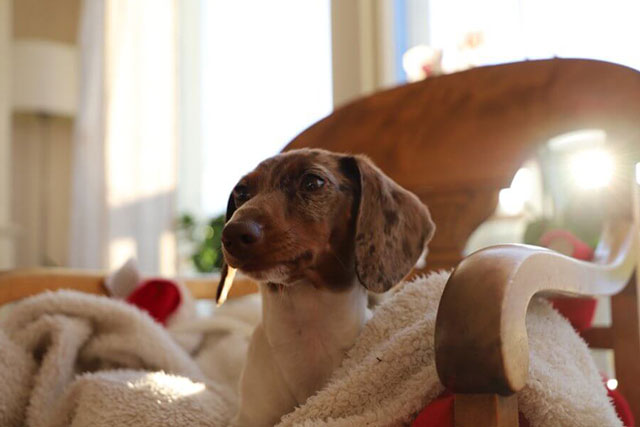
The genetics of Piebald markings in Dachshunds is quite simple in theory. The Sp gene causes a Piebald pattern, it is a recessive gene. Both parents should have one copy of this gene for their offsprings to become Piebalds.
As mentioned earlier, it is a true recessive gene, so, in order to produce a Piebald dachshund, this gene has to be present and carried. Most pure Piebald parents will have an entire litter of Piebald pups.
The Piebald genet is generally considered in science as a genetic abnormality. This irregularity leads to the apparent lack of pigmentation and results in patches all over a dachshund’s coat.
The lack of pigmentation is due to the absence of melanocytes, the cells that create the pigment melanin. Melanin is the part of the DNA and determines coloration, such as hair or eye colour. White coat and blue eyes are in fact, the result from the lack of the color pigment.
Many years ago, this dachshund’s variety was considered a rare one due to its specific patterning. However, in recent times, there has been a surge of breeders rushing to produce this pattern; therefore, Piebald is not rare anymore!
For this reason, you should be cautious when anyone is trying to sell you a Piebald puppy with the claim that they are a rare breed. It is always best to do your research and find a reputable breeder with fair prices.
The best way to help your dachshund live longer?
Watch our video to find out!
What Does Piebald Dachshund Look Like?
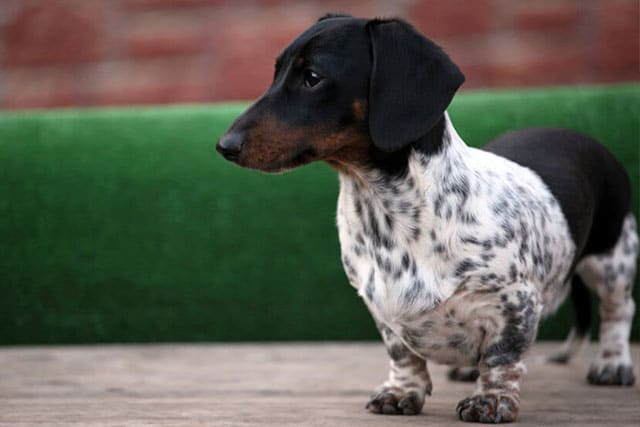
Although there is a large number of Piebalds’ variations out there, there are main guidelines for identifying the Piebald pattern:
- The Piebald pattern is a white spotting that is superimposed over varied self-colours
- The colour of the pattern itself will not vary
- True Piebalds have dark (never blue) eyes
- True Piebalds always have white tips on their tails
- The amount of white colour on a Piebald is variable
- The Piebald’s white coat will have patches of black, grey or brown
- Some Piebalds may have ticking; some may not. Ticking consists of smaller dots of colour present on the white
- The most common Piebald colour is a black and tan
- Other patterns can also be present on Piebald dachshunds. It is possible to have a black and tan dapple piebald!
In general, a Piebald’s pattern will be a colour mixture on the face, white body, and markings all over the white coat. Piebald dachshunds will have four entirely white paws, a white tip on the tail and a white chest. Regular Piebald should show up to 80% of white on the coat.
You can also find Piebalds that are almost entirely white, with just a dash of colour on their heads and their tail base. These dogs are usually called Extreme Piebalds. For the dachshund to be an Extreme Piebald it should have more than 80% of white coat.
Piebald Dachshund Personality
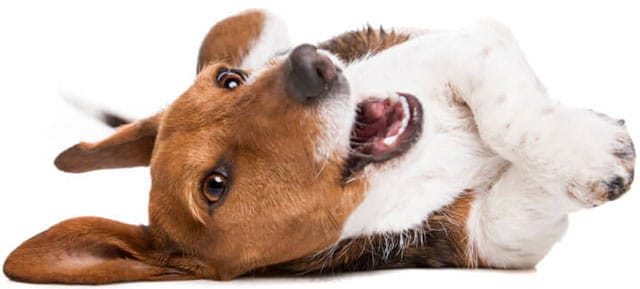
The personality of the Piebald dachshund is very similar to its other Weiner family members. They are fantastic little companions who are a real joy to have in the house.
Despite their small size, they are very courageous, enthusiastic, and playful dogs. Utmost loyal and intelligent, Piebald dachshunds do well in families.
It’s worth mentioning the impressive background of the Dachshund breed as a whole.
The name Dachshund means “badger dog,” they are the small, sturdy and compact dogs. Initially hunters used them to track down for rabbits, rodents, and of course badgers.
An all-time favourite royalty, Queen Victoria, was said to have given this breed a royal stamp of approval!
However, even though piebald dachshunds are ones of the most intelligent and sociable dogs, they can display some negative temperamental traits such as stubbornness and mischievousness.
They are also prone to bouts of yapping and continuous barking, especially if they spot something of interest in the yard or out on a walk. Yet with early training, any problems you may initially encounter should not become too problematic with time.
Some Piebald dachshunds owners notice that their dogs sometimes show a level of separation anxiety, but this can also be managed and corrected.
Difference Between Piebald and Double Dapple Dachshunds
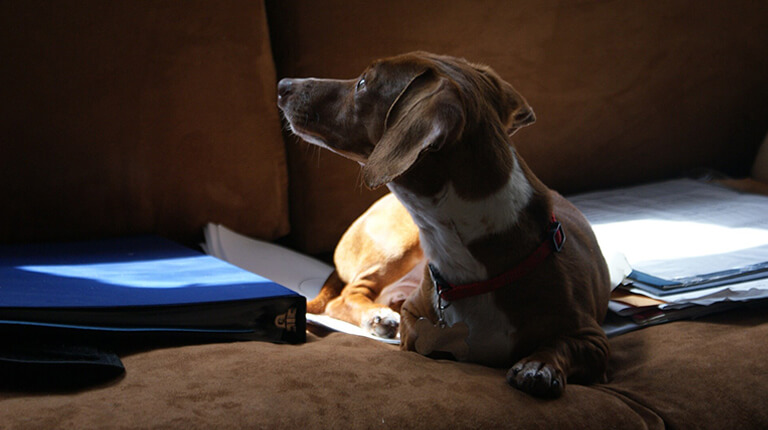
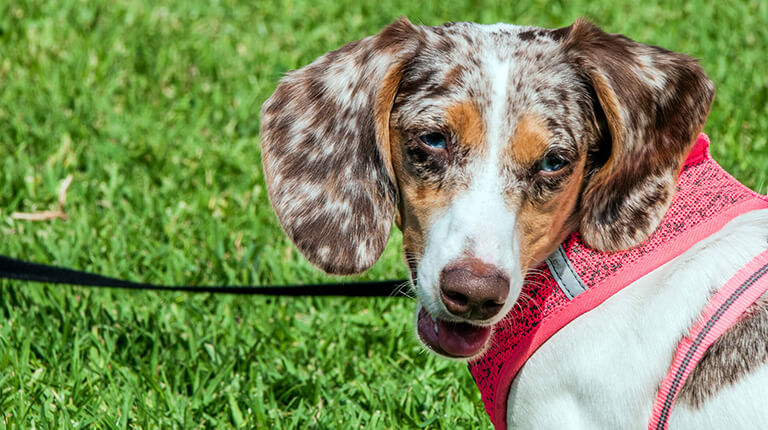
People often confuse the Piebalds with the Double Dapple Dachshunds. They can indeed look very similar, both showing white markings as a base colour.
It is important however to distinguish between a Double Dapple and a Piebald, as Double Dapples puppies have a considerably higher risk of genetic health problems, and are not an acceptable breed standard by the majority of Kennel Clubs.
The differences between a Piebald and Double Dapple dachshunds:
- The Piebald gene is recessive – both parents should carry the gene to have a piebald offspring, whereas The Dapple gene is dominant – one parent with a dapple gene is enough to produce a dapple puppy. However, to produce a double dapple puppy you need two dapple dachshunds to be mated together.
- Piebalds usually, but not always, have more amount of white on their coats, whereas as Double Dapples have patches of white colour
- The shading in a Double Dapple will be notably different than a Piebald – most likely lightened or removed
- This difference in shading is often visible in the spots of a Double Dapple when compared to a Piebald. Double Dapple spots are usually lighter in colour than that of the Piebald
- A Piebald’s markings will often be symmetrically mirrored on either side of its body
- There is no dappling in a Piebald
- A Piebald dachshund will only have brown eyes! It will never have blue eyes or one blue eye. On the other side, Double Dapple dachshunds have more diversity in the eye colouring. The eyes can be blue, brown and hazel; or sometimes have different colours each – one blue and one dark.
- The dappling in a Dapple Dachshund can be either subtle or prominent.
Potential Health Problems in Piebald Dachshunds
Congenital deafness
Congenital deafness (deafness at birth) is encountered in many breeds that carry the extreme piebald gene, i.e. have more than 80% of white coat.
The condition occurs because of the stem cells, responsible for hearing ability. This special layer of cells is located in the dog’s inner ear. They are, in fact, the same type of cells that determine a dog’s hair colour. Without these cells, a dachshund’s body won’t be able to produce a unique layer of hearing cells. This dachshund will, as well, have a coat of mostly white non-pigmented colour.
With all said above, you should be careful when choosing a Piebald puppy. You should look at the amount of white they display. Take a closer look at its head colouring. The puppies with a large amount of white on the head and around the ears may be prone to the congenital deafness caused by a piebald gene.
On the other side, puppies with a nearly all-white body but a solid colouring on their head and ears should not have any problems.
Sometimes it is difficult to find out straight away that your Piebald Dachshund is suffering from deafness. There are specific tests to define it, such as BAER test for example.
If you are interested how pigmentation genes in particular are related to deafness in dogs, there is an interesting article about Genetics of deafness in dogs, issued by Louisiana State University.
Don’t get disheartened if you realise that your Piebald dachshund is affected. Regardless of that condition, with a little bit of assistance, it has all the chances to live a happy and long life.
Other potential health problems in Piebalds
As with all the other types of Dachshunds, the long spine will make it more prone to potential spine issues such as IVDD.
However, being aware of these risks, and taking specific measures to prevent any unnecessary pressure on your dog’s body will minimize the chances of IVDD occurrence.
Keep your Piebald on a diet a healthy diet to maintain its weight – this includes feeding it the right amount of food as well as giving him high-quality, nutritious meals.
Provide regular exercise sessions – though dachshunds sometimes cannot cope with long walks, they can do jogging and can stay actively busy with some toys in the house.
Do not allow your Piebald to jump on and off the sofas, as well as to climb the stairs. It might look like a big job to carry you dachshund up and down the stairs all the time, but this is the primary preventative measure from the IVDD occurrence.
It is important to remember that the Piebald Dachshund is susceptible to the same health conditions as all Dachshunds in general. If you want find out more, feel free to read our article on general Dachshund Health.
One of the most important and effective measures to prevent problems like IVDD is Supplementation.
We highly recommend the Dachshund Advanced Care by Breedology, it is an advanced dietary supplement, precisely formulated for the dachshund breed. Their powerful natural formula includes Chondroitin, Glucosamine and Hyaluronic Acid among other ingredients that work in perfect synergy to provide advanced joint and cartilage support for dachshunds at any age.
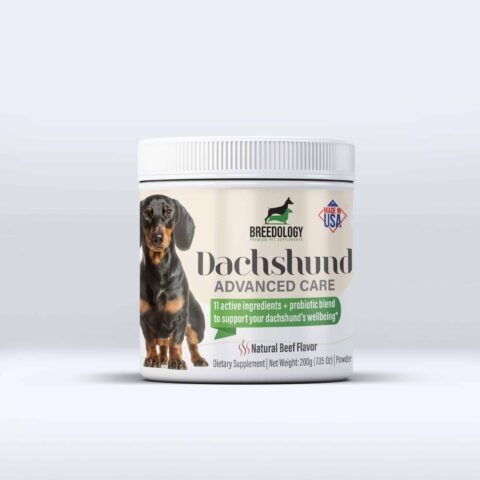
What is your query about?
What does Piebald dachshund mean?
Piebald dachshund is a dachshund with a specific coat pattern, consisting of white spots over the base coat colour. These markings are similar to the ones seen in Beagles, Basset Hounds, or Border Collies.
What is an extreme piebald dachshund?
Extreme piebald dachshund is a dog that has 80% or more of a white colour present to the coat. To go with the white, you will see a spot or two of darker colouring to the coat.
Can you breed Piebald to Piebald?
Yes, you can breed Piebald to Piebald. There are no genetic health complications in this case. On this occasion, the puppies in the litter will be Piebalds.
Can you breed Dapple to Piebald?
The Dachshund breed standards do not allow for the mixing of the dapple and piebald patterns (or any other pattern) you cannot register a dachshund with more than 1 pattern.
Do piebald dachshunds have health issues?
Extreme piebald dachshunds are at risk of congenital deafness, – deafness at birth. Other than that, possible health issues are the same as with any dachshund variety. Dachshunds, in general, are prone to Intervertebral Disk disease, Acanthosis Nigricans, Lafora disease, Cushing’s Syndrome, Obesity, and Eye Problems.
Do Piebald dachshunds shed?
Yes, Piebald dachshunds shed like all dachshund breed varieties. However, the dachshund is considered a low-shedding breed in general.
How do you breed a piebald dachshund?
To get a piebald dachshund offspring, both parents must carry one copy of the recessive piebald gene. Most Piebald parents will have an entire litter of Piebald puppies.
Can piebald dachshunds have blue eyes?
No. While dapple dachshunds can have blue eyes; piebald dachshunds cannot.
Are piebald dachshunds rare?
There has been a surge in popularity for the piebald colouring in dachshunds recently. For this reason, piebald dachshunds are not as rare as they used to be, but they are still not as common as solid coloured dachshunds.
What is a tuxedo piebald dachshund?
A tuxedo piebald dachshund has markings similar to that of a tuxedo cat. This coat pattern will have a lot of dark colouring coupled with white markings over the chest and belly, that looks like a tuxedo. It is often coupled with white markings on the head and muzzle as well.
How long do piebald dachshunds live?
A healthy piebald dachshund can live on average 14-17 years.


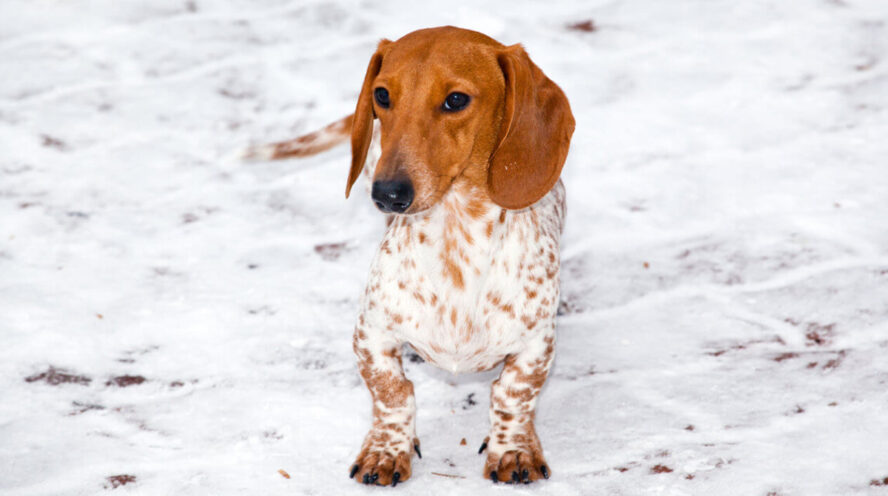
Comments
I have a piebald female dachshund. She is white with black spots. She gets little pustules on the black spots, but never on the white colored hair. I’ve had her to the vet several times. The vet tells us that she has allergies and that is what makes the little sores and loss of hair on her. My question is why does she only get this where there is black hair???
i have a tuxedo shaded cream dachshund and i was hoping i may find a piebald cream male to mate with her – i have not come across any – and i recently saw a Pieblad with blue/grey blotches and i wondered if this being a recessive colour is a safe breeding combination ? I have noted they are clear PRA genetic disease but i was not not sure if the puppies would be shaded cream piebald or tuxedo shaded cream or black and tan tuxedo? As my female dose not carry dilution gene.? Would that be safe combination to mate ?
Hi Melinda, a Piebald with partially blue eyes is most likely a dapple piebald dachshund. (Unless it’s a double dapple but they look slightly different than dapple piebalds). So if you have a dapple gene from one parent’s side, you need to make sure there is no dapple present in another.
Usually a “tuxedo” describes a white mark on the chest and refers to piebalds. Is your dachshund just very light cream? Note, she can also carry a piebald gene, or be a hidden dapple (dapple pattern is not visible in reds and in creams).
As a suggestion, breeding cream to a solid coloured dachshund or cream would be a good idea, Cream dachshunds are very popular nowadays!
I have a male pie-bald, he is amazing. My question is, my friend has a black and tan dapple. Can they be breed with no health problems, she is not double dapple? I plan on getting a female pie-bald. Is it okay to breed?
Hi Tina, mixed patterns are not recognised by kennel clubs. Although the puppies might be healthy, it just creates confusion, dapple piebald dachshunds look very similar to double dapples ( double dapples have genetic complications and shouldn’t be bred). My advise would be to breed a piebald with a solid dachshund or another piebald. Please see our dachshunds’ patterns chart here: https://www.sausagedogworld.com/dachshund-colours/
From what I’ve heard they can mine his mother was a standard dapple and the father a black and tan mini
I have a Piebald who’s grandmother on one side was a dapple will she still carry and pass on that dapple gene to any offspring
Hi Gene, the best advice would be to do the DNA check (you can order the test kit online) for a merle gene if you have suspicion you pup might be a dapple piebald. The mixed pattern should be generally visible on the coat (both dapple and piebald), please see our dachshunds’ patterns chart: https://www.sausagedogworld.com/dachshund-colours/
Hi, my name is Catherine. I have a year old Black and Tan piebald but I want to get her tested to see if she has any dapple genetically. How would I go about doing that? I got her from a friend and have no clue what the parents look like. Thank you in advance.
Hi Catherine, there are quite a few labs that do this testing, depending on your location/ country of residence. You can order the test kit online, it costs around 50 dollars. For example, the Pet Genetics Lab, or https://www.animalgenetics.us/
Hello! I am looking into getting a puppy! I currently have a 3 year old girl. The breeder I found has a male dapple. I asked to see the parents and the dad is chocolate dapple and the mom is chocolate tan piebald. Is this something I should be concerned with?
Hi Marina, it looks like the puppy is a dapple, the pattern he inherited from his dad. Dapples have no probability of genetic complications, as opposed to double dapples.
Hi Catherine! I would recommend going through Embark. I just did so myself for my dog Oliver. One thing I will say about this article is that Piebalds with blue eyes do exist IF they carry the dapple (M Locus) gene. Embark takes about a month to get results back can be pricey. If you ever think about breeding your pupper please take into consideration the risks that Doxies are prone to like IVDD, PRA, and the M locus gene. If you have a dog with a PRA allele just one they are a carrier but not at risk but if you breed them with another dog who is also a carrier the pups will be at risk for blindness. If your dog is a Dapple genetically and does not express it in her coat that is called a hidden or a phantom dapple and should NEVER be bred with another dog who carries the M locus gene as well whether it is hidden in them or not because you are sure to breed puppies with hearing or vision problems. Hope that helps.
Hello i am interested in finding a baby to be mine forever, but i need help with deciding if the litter i found is going to be good! the mother is a dapple piebald and the dad is a piebald! i want to make sure there is no extreme health issues i should be aware of! i’m would be a new dachshund momma so still learning!
Hi Ashley, the kennel clubs discourage mixed patterns in dachshunds, because it creates confusion, and it is possible to mistake a double dapple for a dapple piebald dachshund, they have quite similar colour patterns. In theory, if only one dachshund is a dapple, there will be no double dapples in the litter. So the puppies will be piebalds or dapple piebalds. In terms of a piebald pattern, you do not have to worry about health complications, unless it is an extreme piebald (mostly white) dog.
I breed dachshunds an some times the pups come with a cracked in their tale.Is that unusual?I mean crooked tale.
I breed dachshunds an some times the pups come with a cracked in their tale.Is that unusual?
Hello!
My piebald doxie, Bailey, seems to have lighter (greenish/grey) eyes. However, he is young at only 13 weeks and one day. Will he grow out of his lighter eye color? Or, is he not a true piebald? I am told that puppies this young have different eye colors than what they will have as an adult dog.
I am certain he is a piebald as I got him from a reputable breeder. I know what his siblings look like and they all have brown eyes, unlike him.
What is your take on this?
I have enjoyed reading this article. I love reading about the various dachshund patterns.
Thank you in advance,
Priscilla
Hi Priscilla, in some cases Piebalds can have light brown / hazel / greenish eyes. As long as they are not blue, it’s not a disqualification.
So even if a dachshund can’t be registered with more than 2 patterns, it’s still possible to have a dapple piebald correct? I have 2 piebalds from the same liter. One has white patches on her dapple coat and a blue speckle in one eye. She is gorgeous & the sweetest little thing!
Hi Morgan, yes, of course, you can have a dapple piebald dachshund. The single dapple piebald dachshund should not have any genetic health complications. The Kennel clubs don’t register mixed patterns because of the confusion around the mixed patterns. The main concern here is the unintentional breeding of double dapples. The breeding of double dapple dachshunds is not acceptable by the breed standard, as many DD dachshunds suffer from genetic complications, including congenital blindness and deafness.
To start with, a dapple piebald dachshund is visually very similar to a double dapple dachshund, which might create confusion when breeding etc. Secondly, when you breed the dapple with piebald, the piebald can actually be a dapple piebald dachshund, as sometimes the dapple pattern is not visible. Such breeding can result in double dapple offsprings. Therefore, Kennel Clubs discourage the breeding of the new, fancy patterns and colours in dachshunds and do not register them.
It is genetically possible for two coat patterns to be expressed! Yes! so you can have a dapple piebald and even if you don’t see the speckles in the fur the blue speckle in the eye is a sign or the M locus gene that causes the dappling. True piebald’s do not have blue eyes.
I have a piebald male who through perfect breeding is a wonderful and beautiful dog. He is amazing, sweet, energetic, healthy. I am looking to breed him with a female who is as sweet and a beautiful temperament as he. My male is white with blue eyes. His parents were piebald and dapple mix.
Hi Mary, referring to an AKC breed standard for dachshunds, In Piebalds “Eyes partially or wholly blue is
a disqualification”. The breeding standards do not allow breeding of dachshunds with different patterns, for example a dapple with a piebald. Is your piebald male registered with the KC?
I know that there can be hidden dapple but can there also be hidden piebald? I have a solid (not white) dog that genetically is sp/sp. I’ve never heard of hidden Piebald before.
Hi Phoenix, The S locus in dogs has two known alleles: S (no white markings), and sp (piebald), and combinations S/S,S/Sp,Sp/Sp. Dogs with sp/sp genes will always have a distinctive piebald coat colour, and will pass one copy of sp to 100% of its offsprings. However, if a dachshund also has dapple gene and if a dapple pattern is visible, then these two patterns might overlap, and piebald markings might simply not be distinctive.You will be able to visually tell the difference between double dapple and dapple piebald,- a double dapple will have irregular markings, with no rhyme, as opposed to DP. The hidden dapple only refers to dapple ( merle) gene, as the merle gene can only affect eumelanin pigment (black or chocolate), which is why it can sometimes hide.
P.S. Although mixed patterns in dachshunds exist, the breed standards will not allow mixed patterned dogs to be registered.Due to possible genetic health complications, associated with mixed patterns, you should not breed them together.
My piebald is 5 months old and is always itching? Can it be dry skin? What is best treatment?
Hi Pat, Parasites, including mites and fleas, are the first possible cause you should try to exclude. If, after using flea drops, the itching won’t subside, then you should show your dog to a vet as it might be several different causes including infections (bacterial or fungal) and allergies.
Hi I love the breed and would love to add a health tested piebald to our family. Are there any european breeders or further afield?
Hello,
Congratulations for the nice website! Really interesting and educational about the Piebald Dachshunds!
I had in the past, when I was a kid living with my parents a marvelous chocolate teckel, and I am in love with these funny sausages since then.
Now as a father, I am thinking in bringing home a four legs member to live with my family.
I am really attracted by piebald dachshunds, but they are really difficult to find in Spain, and in Europe.
Can someone recommend a piebald dachshund breeder in Spain, or in Europe?
Thank you very much in advance,
Diego.